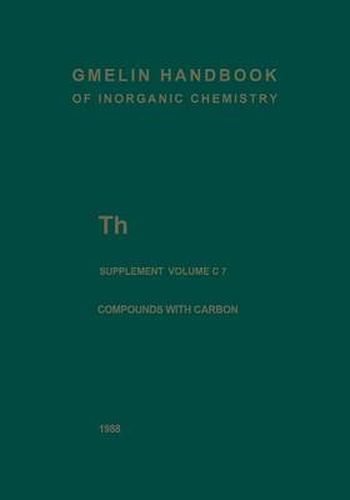Readings Newsletter
Become a Readings Member to make your shopping experience even easier.
Sign in or sign up for free!
You’re not far away from qualifying for FREE standard shipping within Australia
You’ve qualified for FREE standard shipping within Australia
The cart is loading…






This title is printed to order. This book may have been self-published. If so, we cannot guarantee the quality of the content. In the main most books will have gone through the editing process however some may not. We therefore suggest that you be aware of this before ordering this book. If in doubt check either the author or publisher’s details as we are unable to accept any returns unless they are faulty. Please contact us if you have any questions.
The present volume of the Gmelin thorium series describes the solid thorium-carbon compounds with the exception of the carbides and coordination compounds of the type 4 ThAn* X B, where B is a neutral ligand. The complex equilibria of the Th + ion with C-containing complexing agents are treated in the ThD1 volume. A first look into this volume demonstrates that a very large number of ThlV complexes has 4 been prepared. This may be explained by the fact that the Th + ion is the largest tetravalent ion of the periodic table. Therefore, the preparation of complexes with, e. g. , multidentate ligands can give a well-established picture of the coordination number as a function of charge and ionic radius. However, there are very few modern and updated comprehensive treatments of such data. Many compounds described in this volume are characterized by no other means than analytical composition and IR spectra (whereby IR spectra of organic ThlV salts mostly give information only on the ligand). Besides thorium carbonate and carbonato complexes, which are relevant for the environmental behaviour of this radioactive element and some organic complexes like oxalates, which are used in the field of analytical and separation chemistry nearly all other compounds described here are practically only of scientific interest. On the other hand in order to have scientifically reliable data, a very large part of these compounds needs further investigation and characterization.
$9.00 standard shipping within Australia
FREE standard shipping within Australia for orders over $100.00
Express & International shipping calculated at checkout
This title is printed to order. This book may have been self-published. If so, we cannot guarantee the quality of the content. In the main most books will have gone through the editing process however some may not. We therefore suggest that you be aware of this before ordering this book. If in doubt check either the author or publisher’s details as we are unable to accept any returns unless they are faulty. Please contact us if you have any questions.
The present volume of the Gmelin thorium series describes the solid thorium-carbon compounds with the exception of the carbides and coordination compounds of the type 4 ThAn* X B, where B is a neutral ligand. The complex equilibria of the Th + ion with C-containing complexing agents are treated in the ThD1 volume. A first look into this volume demonstrates that a very large number of ThlV complexes has 4 been prepared. This may be explained by the fact that the Th + ion is the largest tetravalent ion of the periodic table. Therefore, the preparation of complexes with, e. g. , multidentate ligands can give a well-established picture of the coordination number as a function of charge and ionic radius. However, there are very few modern and updated comprehensive treatments of such data. Many compounds described in this volume are characterized by no other means than analytical composition and IR spectra (whereby IR spectra of organic ThlV salts mostly give information only on the ligand). Besides thorium carbonate and carbonato complexes, which are relevant for the environmental behaviour of this radioactive element and some organic complexes like oxalates, which are used in the field of analytical and separation chemistry nearly all other compounds described here are practically only of scientific interest. On the other hand in order to have scientifically reliable data, a very large part of these compounds needs further investigation and characterization.